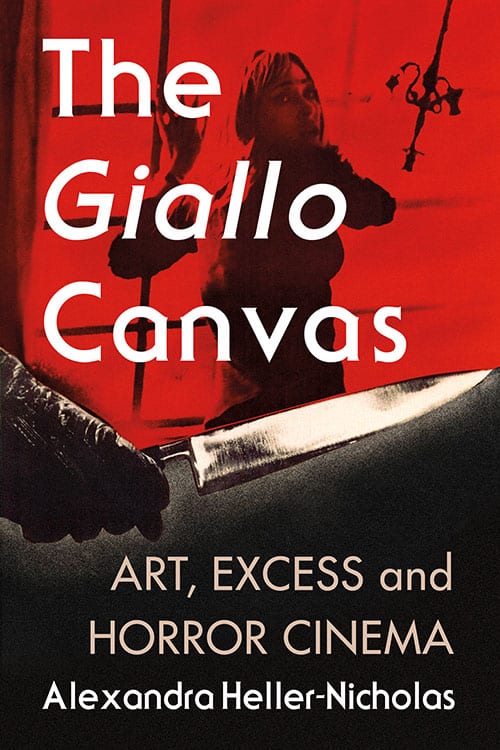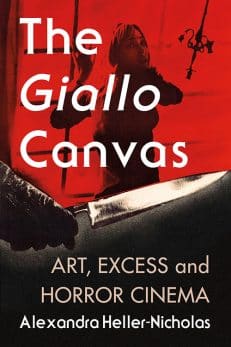The Giallo Canvas
Art, Excess and Horror Cinema
$29.95
In stock
About the Book
Beloved among cult horror devotees for its signature excesses of sex and violence, Italian giallo cinema is marked by switchblades, mysterious killers, whisky bottles and poetically overinflated titles. A growing field of English-language giallo studies has focused on aspects of production, distribution and reception. This volume explores an overlooked yet prevalent element in some of the best known gialli–an obsession with art and artists in creative production, with a particular focus on painting. The author explores the appearance and significance of art objects across the masterworks of such filmmakers as Dario Argento, Lucio Fulci, Sergio Martino, Umberto Lenzi, Michele Soavi, Mario Bava and his son Lamberto.
About the Author(s)
Bibliographic Details
Alexandra Heller-Nicholas
Format: softcover (6 x 9)
Pages: 258
Bibliographic Info: 40 photos, notes, bibliography, index
Copyright Date: 2021
pISBN: 978-1-4766-7539-8
eISBN: 978-1-4766-4076-1
Imprint: McFarland
Table of Contents
Acknowledgments ix
Introduction 1
One—Art, Cinema, Horror, Excess 7
Two—Giallo: Italy and Beyond 27
Famous Paintings
Three—Girls Asleep, Girls Afraid: Vermeer in The Forbidden Room (Anima Persa, 1977) and The Psychic (Sette Note in Nero, 1977) 52
Four—Swan Guts and Screaming Popes: Salvador Dalí, Francis Bacon and A Lizard in a Woman’s Skin (Una lucertola con la pelle di donna, Lucio Fulci, 1971) 70
Five—The Medusa’s Warning: The Stendhal Syndrome (La Sindrome di Stendhal, Dario Argento, 1996) 80
Clues, Presence and Painting
Six—Misreading Clues: Dario Argento’s The Bird with the Crystal Plumage (L’uccello dalle piume di cristallo, 1970) and Deep Red (Profondo rosso, 1975) 94
Seven—Haunted Portraits: The Red Queen Kills Seven Times (La dama rossa uccide sette volte, Emilio Miraglia, 1972) and Your Vice Is a Locked Room and Only I Have the Key (Il tuo vizio è una stanza chiusa e solo io ne ho la chiave, Sergio Martino, 1972) 105
Eight—Paint Death Clearly: Saint Sebastian and The House with Laughing Windows (La casa dalle finestre che ridono, Pupi Avati, 1976) 117
Painters
Nine—A Portrait of an Artist as a Mad Drunk: The Red Headed Corpse (La rossa dalla pelle che scotta, Renzo Russo, 1972) 130
Ten—The Myth of the “Mad” Genius: Vincent Van Gogh and Blood Delirium (Delirio di sangue, Sergio Bergonzelli, 1988) 136
Eleven—The Ghosts of Capitalism: Art, Labor and Exploitation in A Quiet Place in the Country (Un tranquillo posto di campagna, Elio Petri, 1968) 141
Other Art Forms
Twelve—Fashion and Photography 154
Thirteen—Filmmaking 168
Fourteen—Theater and Performance 177
Fifteen—Hybridity 188
Conclusion: Style Is the Substance 207
Chapter Notes 211
Bibliography 231
Index 243
Book Reviews & Awards
• “Nicholas is one of the most perceptive critics working in cinema theory today [and] this volume proves without a doubt that she is a formidable voice who refuses to be silenced.”—Quarterly Review of Film and Video
• “A solid title on the giallo films, particularly for those with an interest in art, that inspires further research and collecting”—popcultureshelf.com
• “Gehring’s book helps strengthen what had been a weak link in the chain of understanding [of Chaplin’s] remarkable career.”— Shepherd Express





